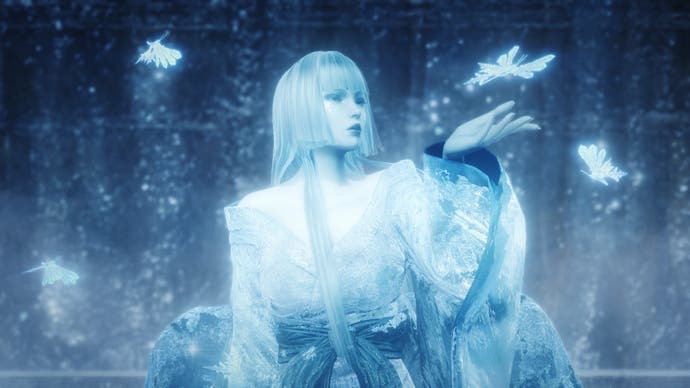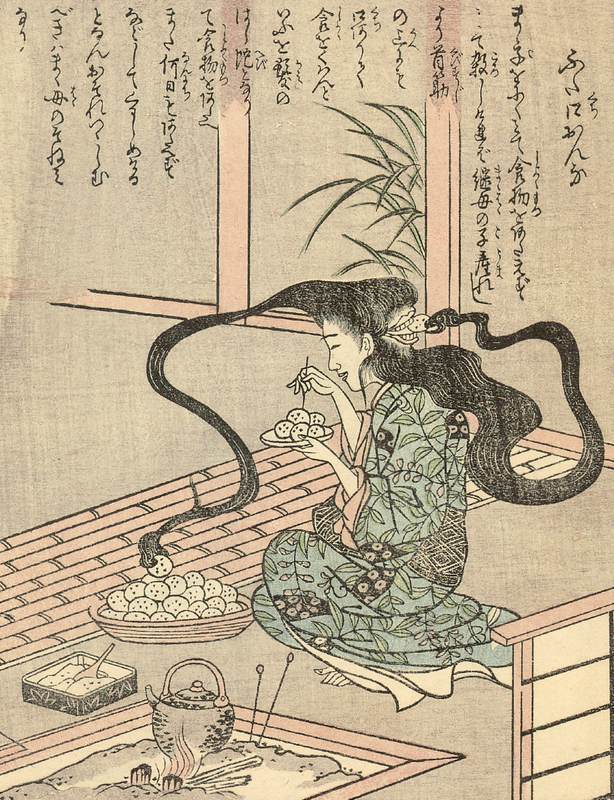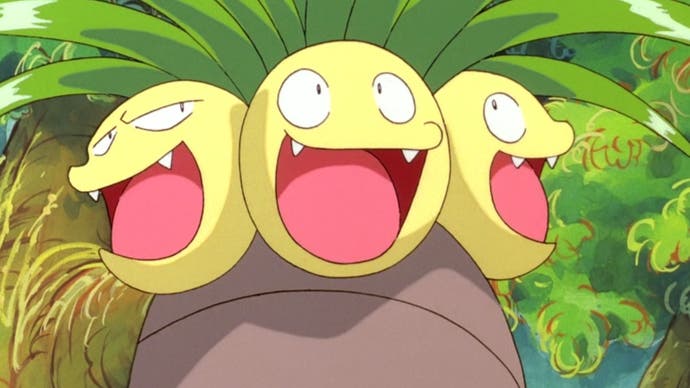The haunted origins of Pok¨Śmon
Gastly tales of the onixpected.
At the time of writing, over 800 Pokémon exist, their influences ranging from shrubs to supernatural entities stretching back eons into Japanese lore. Many are based specifically on Yōkai, strange and grimly comic creatures native to Japan that, like Pokémon, have been recorded in illustrated encyclopedias and playing cards.
Witness this parade of horrors: a head of long black hair that hides a wet, toothy mouth, smiling faces hanging from a tree and swaying with soft laughter, sentient umbrellas that sport long red tongues and a single staring eye (as seen in Nioh), and rotten lumps of flesh that dance on moonlit nights.
These bewitching beasties are the cursed ancestors of Pikachu and his silently screaming cohorts. Take, for example, Grass/Psychic type Exeggutor, a lumbering palm-tree that has up to six expressive humanoid faces. Its origins can be linked to a Yōkai named Jinmenju, or the human-face tree.
Located in remote southern valleys, people once sought its fruit in pursuit of immortality, and planted vast orchards of laughing Jinmenju. It is said that they then picked the trees dry of their delicious fruit until none were left.

One tale goes thus: a traveller strolls alone through a sun-drenched valley. He begins dozing under the branches of a great tree, but is woken up by a chorus of whispering voices. Looking around, he notes a singular tree nearby. It's taller than the rest, with lush, thick tropical fronds that end in flesh coloured fruit.
"Reveal yourselves!" he shouts, suspecting bandits. With a sickening squelch, the tree's plump fruits turn towards him as one, revealing hundreds of cherubic faces. They have wide black eyes and red mouths containing tiny, sharp teeth.
"We are the tree," it announces in a dissonant swirl of whispers, its voice child-like and unwaveringly serious. The traveller screams and staggers back, his foot hitting a rock which sends him flying backwards onto the thick grass. Above him, hearty laughter begins to shake the fleshy fruits.
Its branches heave and snap as the giggling mass sways, and one by one the laughing fruits wilt, and tumble to the ground with rich, wet thuds.
Their baby-smiles turn into grimaces as they land like soft peaches, and a delicious looking ichor seeps out of the fallen ones - which are no longer laughing. Their juice tastes sweet, and somehow sour.

Like this one, many a Yōkai yarn is vague, lacking a distinct moral or narrative conclusion, and instead veers more toward a delight in the macabre, exploring things strange and sometimes deadly.
While reports of them stretch as far back as the 8th century, it wasn't until the proliferation of Yōkai bestiaries, such as the hugely popular Illustrated Night Parade of One Hundred Demons (1776), that the mischievous entities became truly entrenched in Japanese folklore. Parade in this instance translates closer to pandemonium: the contents of the Other World are spilling out, and anyone caught in the procession is likely to perish or be spirited away.
Drawn from a mix of local legends, scrolls and the imaginations of its creators, Night Parade included vivid illustrations of various Yōkai, and instructions on where you could find them. Thanks to Night Parade and its ilk, depictions of the creatures started to standardise, as nebulous lore from different regions became anchored to more widely known definitions.
An example of a Yōkai from one particular area is the Yuki-onna, the basis of Ice/Ghost Pokémon Froslass. Hailing from Japan's frozen north and colder regions, Yuki-onna effectively translates to snow woman - just one of her many names, which all fit within a feminine theme.
She can be wife, daughter, hag, lover and mother. For the most part, she is as deadly as the consuming snowstorms her arrival can foretell. However, her appearance tends to stay the same: pale, beautiful and donning a thin summer kimono ill-suited for winter.

According to some regional variations, she's a hungry vampire prowling through white forests, freezing lost travellers solid after sucking out their souls into her mouth. In others, Yuki-onna is a beguiling lady with jet black hair, who turns into a thin mist of ice when touched by warm hands. She has also been known to call to travellers in the night, throwing them down an icy ravine if they do not respond, and savagely attacking them if they do.
Also included in the villainous-fey-lady Pokémon vein is Ice/Psychic type Jynx: a literal flesh-eating witch of the wilds. Her origins are believed by some to be a dig against Japanese fashion trend Ganguro - whose acolytes apply liberal fake tan, bleach and contrasting makeup - not dissimilar to Jynx's pout and light locks.
However, an offshoot of the style is known as 'yamanba', a reference to Yama-uba: monstrous hags who lure weary travellers to their roadside huts, only to devour them come nightfall.
There's also the Futakuchi-onna, who is replicated in Steel/Fairy (and utterly adorable) Pokémon Mawile, a bipedal creature that sports a gigantic pair of jaws on the back of its head.
This Yōkaii looks like a regular woman from the front, but conceals a hungry surprise in her hair: a second mouth, filled with teeth.
When the red-lipped growth isn't screeching wildly for more sustenance, it's known to mumble spitefully. On the bright side, the mouth squeals with delight as it eats - popping tasty morsels into its maw using strands of snake-like hair. In some illustrations, the hair's learnt to use chopsticks.
The Futakuchi-onna has been known to descend upon the miserly to mete out dark justice. She appears as a prim young woman, so frugal, it seems, that she never eats. The miser, foolish and greedy, rejoices until he is rudely awoken one night by a distant, unearthly chomping.
Not all Yōkai are bloodthirsty, although plenty are. Take for instance, Kitsune, or foxes, which come in shades celestial and holy, or mischievous and evil. They are also known to have a fondness for fried tofu, among other quirms. Beautiful Ninetails,the fox fire Pokémon, is based on the kitsune that have lived for hundreds of years, attaining infinite wisdom, and many tails.
As stories of Yōkai propagated, their influence widened out further, and more became known. During the Edo period (1603 - 1868), when the bestiaries were spreading, Obake Karuta - or monster cards - also rose in demand, remaining popular until the early 20th century.
Unique to Tokyo, the monster cards included colourful illustrations of creatures from Japanese folklore, and were based mechanically on the Iroha-Garuta - a card matching game commonly used to teach children Japanese language characters.
With its vivid illustrations and folklore underpinnings, Obake Karuta could serve as an early precursor to card games like Pokémon and Yu-Gi-Oh! - which also involve collecting and trading a slew of legendary creatures. Curiously Nintendo - although it did not sell Monster Cards specifically - started as a playing cards company in 1889.
The game itself also undoubtedly fed further into Japan's fascination with fantastical beasties, a fancy which modern times saw veering more toward Kaiju - Godzilla and the like.
Plenty of Yōkai from yore have no doubt died over the centuries - missed, forgotten or replaced - just as others drew strange new life through books and drawings. It's odd that lodged inside certain Pokémon are stories ranging back hundreds of years: bizarre rumours and tall tales stoked by oral tradition and old fears, that grew into full-fledged monsters recorded in an encyclopedia.
The Yōkai mentioned here, and the countless others living on, whether through entertainment or local lore, somehow stayed afloat on the ever-changing currents of mass media. They clawed and slithered and danced their way out of our nightmares into our mobiles and consoles, ready to form a grim, chaotic parade, and march into the night once again.

